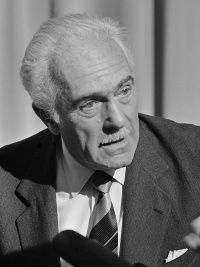Difference between revisions of "Limits to Growth"
| Line 3: | Line 3: | ||
In April 1968, scientists, economists, educators and other individual professionals discussed “the present and future predicament of man” in the meeting organized by the Giovanni Agnelli Foundation and the National Academy of Lincei. As an outcome of the meeting an international organization named “The Club of Rome” was established. | In April 1968, scientists, economists, educators and other individual professionals discussed “the present and future predicament of man” in the meeting organized by the Giovanni Agnelli Foundation and the National Academy of Lincei. As an outcome of the meeting an international organization named “The Club of Rome” was established. | ||
| + | [[File:Aurelio_Peccei_(1976).jpg|200px|thumb|left|alt text]] | ||
The Club of Rome was incorporated on March 1970 in Geneva as a non-profit private association under the Swiss Civil Code [4]. The Club of Rome is an informal organization aimed to stimulate understanding and share knowledge on economic, politic, natural and social components of the real live, as well as, attract attention of policy makers and public globally [3]. | The Club of Rome was incorporated on March 1970 in Geneva as a non-profit private association under the Swiss Civil Code [4]. The Club of Rome is an informal organization aimed to stimulate understanding and share knowledge on economic, politic, natural and social components of the real live, as well as, attract attention of policy makers and public globally [3]. | ||
| Line 8: | Line 9: | ||
A series of early meetings of The Club of Rome culminated in the decision to initiate a remarkably ambitious undertaking -the Project on the Predicament of Mankind. The intent of the project is to examine the complex of problems troubling men of all nations: poverty in the midst of plenty; degradation of the environment; loss of faith in institutions; uncontrolled urban spread; insecurity of employment; alienation of youth; rejection of traditional values; and inflation and other monetary and economic disruptions [1, p.12]. | A series of early meetings of The Club of Rome culminated in the decision to initiate a remarkably ambitious undertaking -the Project on the Predicament of Mankind. The intent of the project is to examine the complex of problems troubling men of all nations: poverty in the midst of plenty; degradation of the environment; loss of faith in institutions; uncontrolled urban spread; insecurity of employment; alienation of youth; rejection of traditional values; and inflation and other monetary and economic disruptions [1, p.12]. | ||
| − | + | ||
---- | ---- | ||
== References == | == References == | ||
Revision as of 23:14, 14 January 2020
Historical Background
In April 1968, scientists, economists, educators and other individual professionals discussed “the present and future predicament of man” in the meeting organized by the Giovanni Agnelli Foundation and the National Academy of Lincei. As an outcome of the meeting an international organization named “The Club of Rome” was established.
The Club of Rome was incorporated on March 1970 in Geneva as a non-profit private association under the Swiss Civil Code [4]. The Club of Rome is an informal organization aimed to stimulate understanding and share knowledge on economic, politic, natural and social components of the real live, as well as, attract attention of policy makers and public globally [3].
A series of early meetings of The Club of Rome culminated in the decision to initiate a remarkably ambitious undertaking -the Project on the Predicament of Mankind. The intent of the project is to examine the complex of problems troubling men of all nations: poverty in the midst of plenty; degradation of the environment; loss of faith in institutions; uncontrolled urban spread; insecurity of employment; alienation of youth; rejection of traditional values; and inflation and other monetary and economic disruptions [1, p.12].
